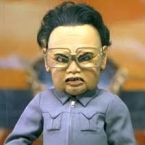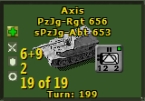docgaun
Posts: 71
Joined: 1/26/2012
Status: offline

|
yes, when its done ill send it to him. I need somone to read the briefing trough. English is not my prime language, so it would be nice to have it corrected;) Allso input on various subjects are much welcome.
Here is an exampel form the Briefing, any comments would be appriciated.
Production and replacements:
The Eastern front was a virtual meat grinder, with horrific casualties on both sides. There is no official data on how many percent that were actual rifle squads and how many were in the supporting arms services (Artillery, Armored force, supply and logistic ect), however its logical to assume that these element had fewer casualties than the front line infantry. To calculate squad replacement we have estimates form a number of sources stating that 1/3 of casualties were in these armed services, and 2/3 in the line infantry.
Trucks, either stolen, lend leased or produced 2/3 is going to the logistic support and only 1/3 for the combat troops. Same goes for Jeeps types.
Every nation has its own squads. So there will be Finish SMG squads, Italian SMG squads and so on.
Axis:
At Barbarossa 75% of the German strength was employed in the east. This is represented by the actual units on map.
Up until 1943 the German industry was not mobilized for war, there was a shortage on skilled labour that only became worse when new recruits were drawn into the armed services. It’s a paradox, that this shortage actually improved the living condition of Soviet POW from 1942, as they were badly needed as labor. German tanks and aircraft production peeked in late 44 ( Aug-sep) as Guderian and Speer were able to reform the German industry to a more coherent war time production. It was never perfect, and almost the entire war the Germans had an abundance of raw material compared that their Soviet counterpart.
The production increase can be seen from the increased numbers of new equipment. These numbers are historical.
Historical facts taken into account:
- The Germans had between 62-67% of their armed forces in the East at almost any giving time (with very few exceptions e.g the Ardennes offensive).
- The Axis forces were totally destroyed meaning that all manpower were killed or captured
To apply history we done the following:
- 2/3 of the total historical German production goes to the Eastern Front
- 100% of Axis allies goes to the Eastern Front
Total German losses to 30 April 1945 amounted to 13,488,000 men. That’s 75% of the mobilized force and 46% of the male population in 1939. Of these 10,758,000 were captured or killed in the east.
To calculate the replacements we have done the following:
- 1/3 of-the casualties were in non-squad units (Artillery, Navy, Aircraft, Panzer force ect.).
- As the entire force was eventually captured or destroyed we have subtracted the in game squad numbers, from the remaining total.
- Each squad is considered to consist of 10 men.
This results in 717.200 squads minus the fielded Army. The quads are then distributed according to the starting Matrix. (Relative percent of fielded MP/Rifle squads ect.)
Axis Allies:
The same rules as above apply to German allies:
Nation Dead/Missing POWs Totals Fielded Army To Matrix
Hungary 350.000 513.700 863.700
Rumania 480.000 201.800 681.800
Finland 84.000 2400 86.400 Not Relevant
Italy 45.000 48.975 93.975
Slovak 3.478 911 7.587 Not Relevant
Others N.A 464.147 464,147 Not Relevant
Others include, French, Czech, Belgium, Spanish, Danish, SS volunteers, Ost Legion ect. As there is no historically numbers for manpower killed or missing, the POW number represents the total loss, and the starting squads are NOT subtracted.
The number that goes to the Matrix is calculated the same way as the German. (2/3 Total number /10 (men pr. Sq) minus fielded squads)
Soviet Manpower.
Much too contrary belief, the Soviet Union did not have an endless supply of manpower. It did however from the start of the war posses a vast pool, of semi trained men that could be mobilized for action. In 1938 the basic military service was introduced again, for every man from age 18-50. This gave a total of 14 million men with at least basic training when the war started. This vast pool was the reason that the Red Army could sustain such heavy losses, and still continue to grow. By June 30, 1941 5,5 million reservist were called up, and this was matched by 5,5 million volunteers. A grand total of 11 million men were joining the Red Army within 2 weeks of the war. These men were however not of the same standard as the personnel lost in the standing army in summer of 41. This combined with the poor quality of the commanding officers made for the continued heavy losses for the rest of 1942. By December 1941 the Soviet Union had raised 97 reserve divisions, formed 194 new divisions, and 84 brigades. The soviet armed forces reached at total of 11,5 million in 1943, with 6,5 million in front line service. These numbers remained almost constant for the remainder of the war.
The total number of Soviet losses is always going to be a guess. The documentation form soviet archive has the confirmed number of 28.199.127 military losses. It’s naturally to guess that the actually number is larger since not all enlisted men were accounted for in the desperate months of 1941
We have implemented the same calculations as with the Axis, however these are actually losses and the standing army is not subtracted.
This means the total numbers of squads to put into the matrix are: 2/3x 28.199.127 /10 (men pr squad) = 1.879.942 Squads
Withdrawing units:
These units are calculated into the all-time manpower / equipment production, and they should be disbanded before they withdraw, since the players have already “paid” for them.
Soviet wartime production.
The heavy disruption during Barbarossa means that the Soviet production first starts in December 1941. The arriving units, until then, represent the relative small production that occurred until December. Factories are to be moved as the Soviet player sees fit. It has no cost on production. However, if they are lost they will reduce the overall production. So take great care and don’t lose a single one, or it will affect your entire war production. The Soviet player can “gamble” keeping the factories in their historically location, as they are formed as supply units and will add to the recovery of adjacent units.
The starting reserve pool, reflects the official 22 june 1941 stock pile, (The equipment in depots) and the frantic manpower mobilization in the first few weeks.
|
 Printable Version
Printable Version















 New Messages
New Messages No New Messages
No New Messages Hot Topic w/ New Messages
Hot Topic w/ New Messages Hot Topic w/o New Messages
Hot Topic w/o New Messages Locked w/ New Messages
Locked w/ New Messages Locked w/o New Messages
Locked w/o New Messages Post New Thread
Post New Thread